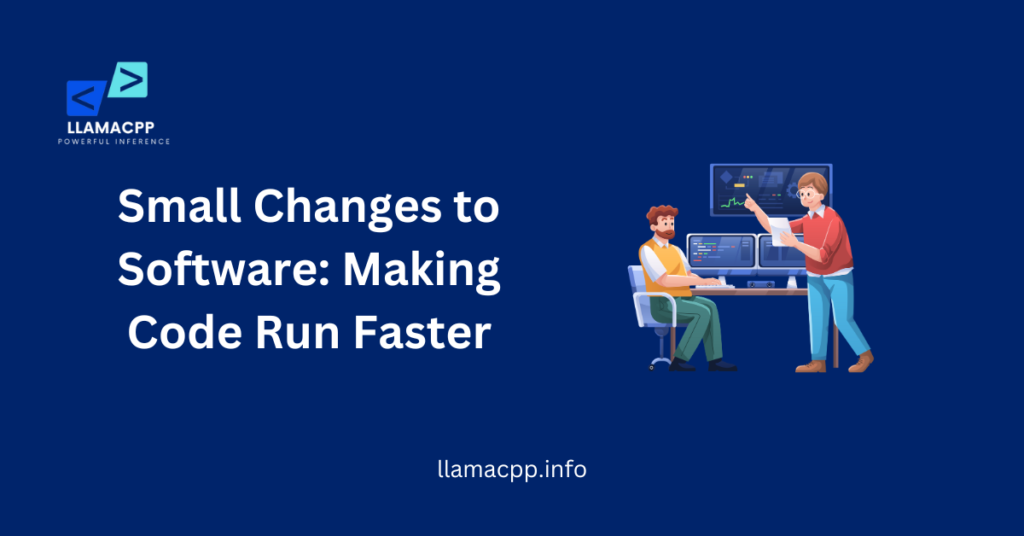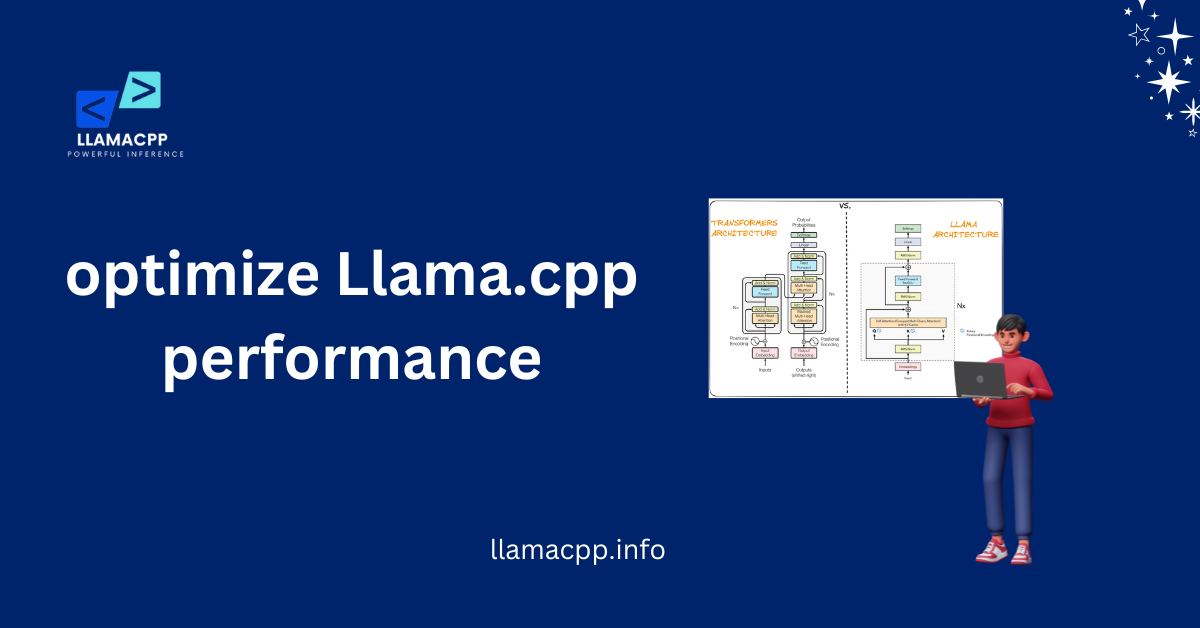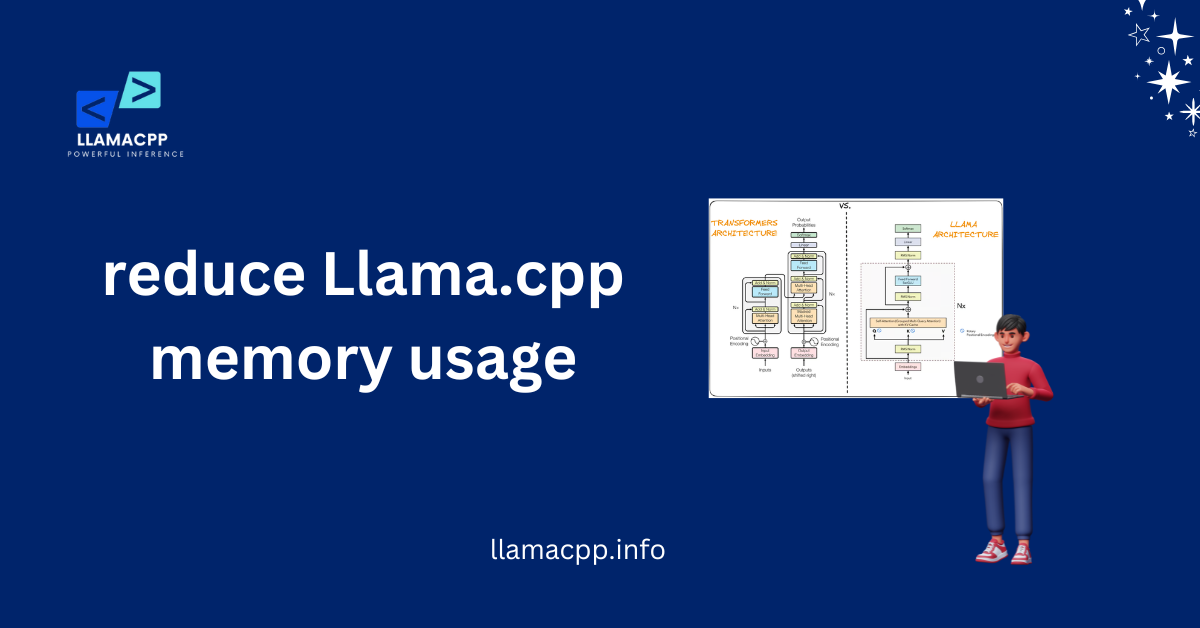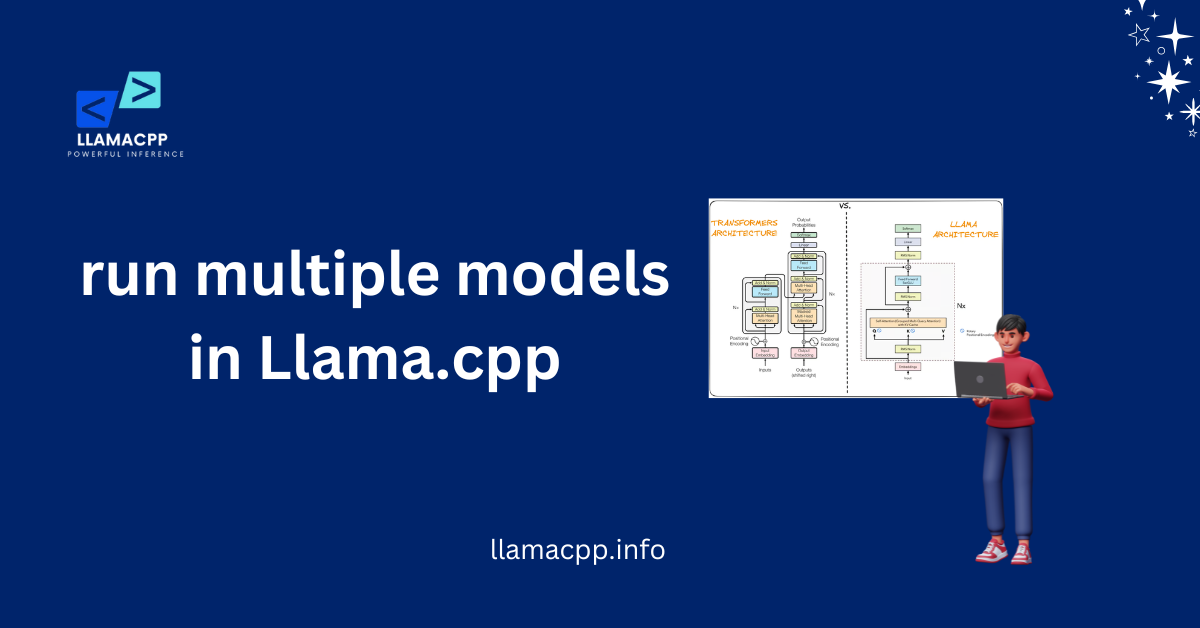Table of Contents
ToggleIntroduction
optimize Llama.cpp performance, To get the most out of this powerful tool, make Llama.cpp run faster. It is easy to use Llama.cpp for language and machine learning jobs. Though, if something is wrong, it might be slow and use up too much space. That’s not good.
The good news is that making Llama.cpp run faster can help. Make a few easy changes, and it will run faster and use fewer resources. There are many ways to make things run faster, such as changing your hardware, modifying some code, or taking better care of your memory. In this post, we will show you how to optimize Llama.cpp performance and make it work better.
What is Llama.cpp, and why does it matter?
A library called Llama.cpp helps run machine learning models, mainly for language jobs. It’s free and powerful, but you need to improve Llama.cpp speed to get the most out of it. Linq to Llama.cpp can be slow, use too much memory, and cause delays if it is not optimized. Make sure it works well and quickly by making a few minor changes.
Improve Llama. Performance in CPP is essential because going too slowly can cause time loss. Things get done faster when everything goes faster, and you don’t have to worry about your system getting too busy. So, getting better at what you do makes a big difference. We’ll talk about why it matters and how it impacts your work in this part.
1. Learn how Llama.cpp works
It is a C++ library called Llama.cpp that was made to work with big machine-learning models. It’s made to handle a lot of information, but it needs to be set up correctly to work well. You can improve its speed to ensure that Llama.cpp works at its best.
2.Impact of Performance on How Well Things Are Done
If you improve Llama, CPP’s performance will speed up jobs, reducing stress on your system. This means you’ll have to wait less and get better results. It is easier to get work done when your model is faster.
3. Why you need to improve things
Optimization is key! Even with a powerful tool like Llama.cpp, you can slow things down if you don’t tweak them just right. By improving your system, you can ensure it works well, has fewer delays, and gives you the best results. Making small changes can change a lot.
Getting the most out of your hardware: picking the proper setup
The gear you use is essential if you want to get the most out of Llama.cpp. Even the best code can run slowly if your computer’s hardware isn’t strong enough. To get the most out of Llama.cpp, you need to make sure you have the right tools. Making sure your system is ready for the job will help Llama.cpp runs faster and uses less space.
For any machine learning job, you need to ensure your hardware is set up well. You must have a strong CPU and enough RAM. Adding a GPU can speed things up. In the next few parts, we will discuss how each piece of hardware impacts Llama.cpp and how you can choose the best ones to make Llama.cpp run faster.
1. CPU: The Heart of Performance
Your computer’s CPU is its brain, and it has a lot to do with how fast your tasks run. A powerful CPU can quickly do complicated maths. A multi-core machine is the best way to get the most out of Llama.cpp. More cores in your CPU mean it can do more things at once, which speeds up the whole process. Thus, pick a CPU that can handle the games you want to play.
2. RAM: The Power of Memory
RAM is where the info that your computer needs right away is kept. Large files will be complex for your system to handle if it doesn’t have enough RAM, which will slow it down. More RAM lets your computer handle more data at once, which is excellent for running machine-learning models. Make sure your system has enough memory for the jobs you’re doing to get the most out of Llama.cpp.
3. GPU: Speeding Up Large Tasks
It is very easy to speed up work with the GPU, especially when working with big machine-learning models. The GPU can do many things at once, while the CPU only does one at a time. Because of this, it is excellent for working with lots of data and making calculations go faster. If you want to really optimize Llama.cpp performance, adding a GPU to your setup can make a world of difference, especially for complex jobs.

Small Changes to Software: Making Code Run Faster
It’s just as essential to improve your code as it is to choose the right tools to get the most out of Llama.cpp. Destructive code can slow things down, even if the system is robust. Code optimization makes programs run faster while using fewer resources. Making small changes to how you write your code can make integrate Llama.cpp with a chatbot much quicker.
When you optimize your code, you eliminate unnecessary steps, use less memory, and make things run faster. These changes will help Llama.cpp works better and gives you better results. Next, we’ll show you how to make easy changes to the code to make things run faster and better.
1. Remove any loops that aren’t needed.
Adding loops that aren’t needed can slow down your program. If you’re repeating a loop without any real reason, it’s time to rethink it. Removing or simplifying loops can speed up the process and help you optimize Llama.cpp performance. A minor cleanup here can go a long way.
2. Use algorithms that work well.
The algorithms you use affect how fast your program runs. Some programs work quicker and use fewer resources than others. To optimize Llama.cpp performance, move to quicker algorithms that process data more effectively. This simple change can save you lots of time, especially when working with big data.
3. Make the best use of memory
Using memory efficiently is very important for performance. Too much memory use can make your code run more slowly or even crash. To optimize Llama.cpp performance, be mindful of what data you put and when. Remove an idea when you’re done with it. This keeps your system running smoothly and speeds it up overall.
Memory Management: Cutting Down on Extras
To get the most out of Llama.cpp, you need to make sure that memory is managed well. If your program takes up too much memory, it might run more slowly or even crash. Cutting down on memory overhead makes sure that your system runs efficiently and doesn’t use up all of its resources. By carefully managing how memory is allocated and freed up, you can significantly improve the performance of Llama.cpp.
To optimize Llama.cpp performance, it’s important to keep memory use to a minimum. This means getting rid of memory you don’t need and not allocating too much memory. Handling memory well keeps your system from slowing down, especially when you’re working with big datasets.
1. Free up memory that isn’t being used
Getting rid of memory when you’re done using it is a simple way to reduce memory waste. If your computer uses memory that isn’t needed anymore, it can slow things down. By clearing out unnecessary data, you free up space for more important jobs, which helps optimize and load a model in Llama.cpp performance and keeps things working faster.
2. Don’t let memory leak.
When your program doesn’t free up memory that it’s no longer using, this is called a memory leak. These leaks can add up and slow things down over time. To optimize Llama.cpp performance, ensure that your program releases memory properly when it’s no longer needed. This will avoid slowdowns and keep your system from crashing due to excessive memory use.
3. Use your brain Data structures that work well
It’s also essential to pick the right data structures when handling memory. It’s better to use less memory than more memory, which helps cut down on waste. To get the most out of Llama.cpp, use data structures that use less memory whenever you can. This way, you can work with large datasets without using too much memory, improving overall speed and performance.
Parallel Processing: Enhancing Computation Speed
Parallel processing is a great way to improve Llama’s performance. Instead of processing jobs one by one, parallel processing splits the task into smaller parts. All of these parts work together to make the process go faster. By dividing the work, Llama.cpp can handle complex tasks faster, even when the data is large.
Using parallel processing can make a big difference in optimizing Llama. cpp performance. It lets your system use multiple CPU or GPU cores to work on different parts of the code at once, making things run more smoothly and cutting down on the time it takes to complete jobs.
1. Multi-core CPUs
One way to speed up processing is to use CPUs with multiple cores. The different parts in these CPUs can do other things simultaneously. Make sure your system is set up to use all of its cores to get the most out of Llama.cpp. This helps divide the work and speeds up your system.
2. Speeding up the GPU
GPU acceleration is another excellent tool for parallel processing. GPUs can do many things at once, which makes them faster for doing complicated maths. To optimize Llama.cpp performance, turn on GPU acceleration for jobs that need it. This will speed up the process, especially when working with big numbers.
3. Scheduling and splitting up tasks
When using parallel processing, it is important to split up jobs so that each part can work on its own. Also, jobs should come together smoothly at the end. To get the most out of Llama.cpp, make sure your jobs are split up well and are in sync. This keeps things from slowing down and ensures everything goes smoothly.
Fine-Tuning Model Parameters for Efficiency
This is a critical step in making a Llama. CPP works better when the model settings are fine-tuned. Even the best code can be slowed down if the model choices aren’t right. By adjusting parameters, you can ensure that the model runs faster and more efficiently. Fine-tuning ensures that the system doesn’t waste time or money on things that aren’t important.
Fine-tuning helps you get the best results with less effort to optimize Llama. Cpp performance. Adjusting parameters like learning rate, batch size, or activation functions can make a huge difference. It’s essential to find the sweet spot where the model works quickly and correctly without putting too much stress on your system.
1. Adjusting Learning Rate
How fast a model changes, the learning rate controls its weight. If it’s too high, the model might go too far from the best answer. If it’s too low, the model might take too long to converge. Carefully change the learning rate for a faster, more balanced learning process to get the most out of Llama.cpp.
2. Choosing the Right Batch Size
Batch size affects how many training examples the model processes at once. A bigger batch size makes training go faster, but it also uses more memory. It might take longer with a smaller batch size, but it will use less memory. To make Llama.cpp work better, find a batch size that is fast and doesn’t use too much memory.
3. Tuning Activation Functions
Activation functions help choose whether to turn on or off a cell. Some functions work better for specific jobs than others. To optimize Llama.cpp performance, experiment with different activation functions like ReLU or Sigmoid to find the one that offers the best speed and accuracy for your model.
What bottlenecks are and how to get around them
Bottlenecks can make Llama.cpp run more slowly. Memory problems, slow computations, or code that doesn’t work well may be to blame for these problems. To get the most out of Llama.cpp, you need to find and fix these issues. By doing so, you can speed up the whole process and use your system to its fullest ability.
Recognizing and solving bottlenecks is the way to increase efficiency. Whether you are upgrading your hardware, optimizing your code, or better managing your resources, solving these issues can get your system dashing. You can realize that Llama.cpp runs better after these modifications, which saves you effort and time.
1. Memory Bottlenecks
Memory is often a big culprit behind slow performance. When your system doesn’t have enough memory to run jobs smoothly, it can lead to delays. You need to make better use of memory to get the most out of Llama.cpp. You should use smaller, more efficient data structures and get rid of data that isn’t being used. If needed, adding more memory can also help.
By managing memory correctly, your system can operate without constantly transferring data between the disk and memory. This provides a smoother experience and more rapid processing, particularly for bigger operations or advanced models.
2. CPU and GPU restrictions
Your GPU and CPU are responsible for quick working speeds. If they aren’t strong enough, things can move more slowly. To optimize Llama.cpp performance, try upgrading your hardware. A faster CPU or a stronger GPU will help make things go faster.
You can also handle things simultaneously. You can do more than one thing at once, which makes better use of your hardware. This is especially useful for big projects that require heavy computations.
3. Inefficient Code
Code that doesn’t work well can waste time and resources. Unnecessary loops, redundant processes, or slow functions can cause significant delays. Review your code carefully to get the most out of Llama.cpp. Look for areas where you can reduce operations or improve algorithms.
By improving your code, you can make your system work better. This will save time and computing power, leading to faster performance and better overall results.
Conclusion
In conclusion, optimize Llama.cpp performance is essential for you to get the most out of your system. By addressing common bottlenecks like memory limits, CPU/GPU restrictions, and inefficient code, you can significantly improve processing speed and efficiency. Each step helps make the experience smoother and faster, whether it’s upgrading hardware, handling memory well, or tweaking your code.
A proactive method is key to optimize Llama.cpp performance. Check your code and system for speed issues on a regular basis. By making these changes, you can enjoy faster results and make your system work more efficiently. If you pay attention and put in a bit of work, it won’t take long to get the most out of Llama.cpp.
FAQs
1. What is the most important thing to do to make Llama.cpp run faster?
Finding and fixing bottlenecks is the most important thing. Finding the problem and fixing it will make the biggest difference in speed, whether it’s memory problems, CPU/GPU limitations, or code that doesn’t work well.
2. How can I improve memory management to optimize Llama.cpp performance?
You can manage memory better if you use efficient data structures, eliminate unnecessary memory, and add more RAM. Good memory management prevents processing from being slowed down and delays from happening, especially when dealing with large datasets.
3. Does upgrading my CPU or GPU help improve Llama’s CPP performance?
Yes, upgrading your CPU or GPU can make things run much faster. More powerful hardware allows for faster computations and better handling of large or complicated tasks, which is crucial for optimize Llama.cpp performance.
4. How do I make my code more efficient for better performance?
Streamlining your code can make it run faster by eliminating unnecessary loops, improving algorithms, and avoiding doing the same thing twice. This ensures that your system spends less time processing and more time producing results.
5. What are some common bottlenecks in Llama.cpp, and how do I fix them?
Memory limits, slow CPUs and GPUs, and code that doesn’t use resources well are all common bottlenecks. To fix these, you can optimize memory usage, update hardware, and review and improve your code for better efficiency. Addressing these issues will result in smoother and faster performance.



















